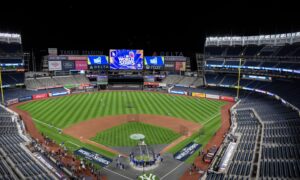It’s the dawn of a new era for Major League Baseball. With the 2023 season just around the corner, most baseball fans are interested to see how new rules and a new schedule will impact a game that has withstood the test of time but gotten a bit stale and fallen behind other sports in a level of excitement that’s needed to keep longtime fans interested, and attract new fans.
This season, pitches will be timed, shifts will be limited, and the bases will be bigger. Pitchers must pitch within 15 seconds after getting the ball with empty bases.
The time limit is 20 seconds when there are runners on the bases. The timer stops when a pitcher goes into his pitching motion. Exceeding the time limit will result in an automatic ball.
Get in the Batter’s Box
There’s also a 30-second limit between batters. Violation of that rule will result in a strike. The 30-second limit can be longer under several scenarios, including when a fielder needs to return to his position after chasing a foul ball, the umpire brushes dirt off home plate, or after a base hit when the ball is returned to the infield.
As for shifts, a defensive team must have at least four players on the infield and two fielders on either side of the second base. That should increase batting averages. First, second and third base has gone from 15 to 18 inches on each side to make the game safer.
Because of the bigger bases, the distance between bases will be slightly shorter, perhaps resulting in more safe calls on bang-bang plays.
Fewer Division Baseball Games
As for the schedule, the number of games each team will play against division teams has been reduced from 19 to 13 so that each team can play all 29 other teams. There won’t be 19 games between the Tigers and Royals and Reds and Pirates, thankfully.
And no more situations like the Phillies going 16-3 against the Nationals last season and earning the wild card spot in the playoffs by one game or the Orioles, Blue Jays, and Rays having to play nearly a quarter of their schedule against the perennially strong Yankees and Red Sox.
This will be the first time since interleague play began in 1997 that each team will play everyone else. Each team will visit every other Major League city at least once every other year.
The new rules will be enforced from opening day … of the exhibition season. There won’t be a grace period.
“Our experience (experimenting with the new rules in the Minor Leagues) suggested that we’re better off putting in the rules changes and moving through the adjustment period as fast as we can,” Commissioner Rob Manfred said this week during a press conference in Arizona.
The rules changes result from MLB surveys of fans asking what changes they’d like to see in the game—the new schedule results from team owners suggesting how to bring more fans into their ballparks.
“When you play more games outside your division, almost by definition, travel is going to be a little worse,” Manfred said. “But we feel it will be worthwhile because we’re trying to improve the game for fans.”
Automatic Runner Stays Put
One rule that’s not changing after it was put in place during the pandemic-delayed 2020 season is the automatic runner. That rule places a runner on second base with nobody out at the start of each half-inning in extra innings. Traditionalists don’t like the rule, but it was a change that was desperately needed in a sport where nine-inning games routinely run longer than three hours.
“Clubs like the rule because it saves them from putting excessive strain on their pitching staffs or putting position players out there to pitch when they’re not used to pitching,” Manfred said. “The rule also eliminates that really long game.”
About the Author









